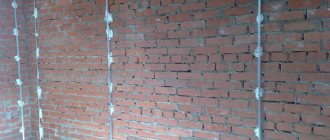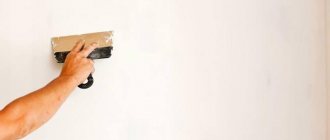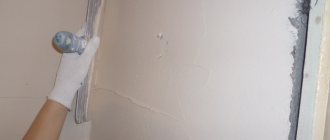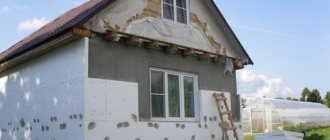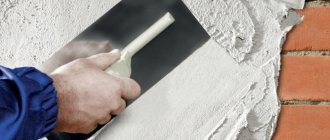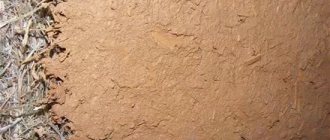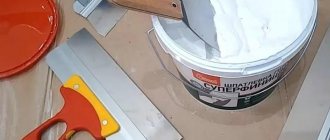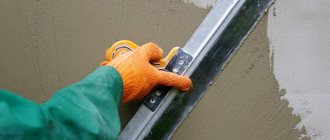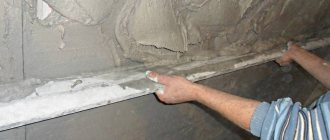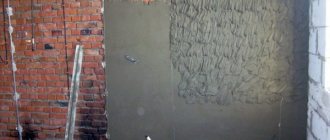Clay plaster is an environmentally friendly, budget-friendly and easy-to-apply material and is used for decorating cottages, insulating and decorating wall panels. Using the mixture, different types of decorative textured coatings are created to suit the style of the building. Sawdust, polystyrene foam granules, etc. are added to the plaster composition.
Types of clay-based plasters
Based on the origin of the material, clay-based plasters can be of the following varieties:
- Monomineral
— the composition is formed during the decomposition of one type of minerals. Clays can be kaolin, halloysite, formed after the decomposition of spar, etc.
- Polymineral
clays are formed from different components, in addition to kaolin, they contain other minerals. Additives affect the shade of the clay mass. The compound often contains small particles of rocks or minerals and organic components as impurities. The chemical composition of clay affects the technological properties of the material.
According to the color scheme, clay can be of the following types:
- blue;
- white;
- red;
- gray;
- yellow;
- black.
To give a different shade to the clay mortar, you can use dry coloring, which is added to the diluted building mixture.
The clay composition does not have the required strength, therefore it is used only for interior decoration after applying lime-gypsum or lime mortar on top. To increase strength, the mixture is prepared with the addition of lime, cement or gypsum.
Depending on the type of combined binder, the clay mass is divided into the following types:
- Clay-lime mortar
prepared from diluted clay (1 part), lime dough (0.4 parts), sand (3-6 parts). The components are mixed to create a liquid solution. The composition is suitable for treating surfaces made of wood and concrete.
- Gypsum-clay mixtures
. Gypsum, clay and lime mortar are mixed before applying to the surface. The work is carried out promptly, because the composition dries quickly. The product has a creamy consistency and is used for interior work. Plaster with the addition of gypsum has high thermal insulation parameters, is easily distributed over surfaces,
- Cement-clay compositions
They are characterized by strength, a good degree of adhesion to the surface, and plasticity during application. The material is used for interior finishing work. The composition is optimal for application to stone surfaces, concrete bases, processing of protruding parts of the room, arches, and ceilings.
- Clay-acrylic solutions
They are distinguished by waterproof characteristics, strength, durability, and ease of application. The material can be used for decorative plaster and creating original design solutions indoors. The composition is distinguished by a variety of colors, reliable adhesion to the surface, and simple decorative processing.
According to purpose, clay is divided into the following types:
- standard;
- decorative
Varieties of clay-based finishing materials differ in the composition of fillers. To increase strength, sawdust, chopped straw, dried pine needles, artificial granules and fibers (expanded polystyrene, fibers) can be added.
According to the type of filler, plaster can be of the following subtypes:
- Sandy
— clay mortar with the addition of sifted river sand is optimal for finishing wood walls in cases where additional thermal insulation of surfaces is not required. The proportions of clay and sand for plaster are determined by the purpose of the coating (external, internal) and the requirements for the plasticity of the mass.
- Clay-based plaster with sawdust
used for the design of external and internal wall panels. Wood fibers increase the strength of the plaster layer after hardening. The composition of clay with sawdust improves the heat and sound insulation of the room. This solution can be used as a decorative textured layer.
- A mixture with the addition of straw, pine needles, felt fibers
becomes more flexible and durable after hardening. The thermal insulation characteristics of the clay composition are increased. The fibers also act as a reinforcing layer, increasing the strength of the wall panels and the durability of the mortar.
- Combined clay composition including sand and fibrous fillers
optimal for finishing building facades. A solution of clay and sand with the addition of fibers is characterized by increased strength, resistance to cracking under the influence of direct sunlight, and high humidity during periods of precipitation.
Leveling with plasterboard sheets
When installing plasterboard sheets, do not forget that this method of leveling the walls will noticeably reduce the space of the room.
Wall covering with plasterboard sheets
When preparing walls for this method, it is necessary to eliminate traces of dampness (the plasterboard sheet gets wet and destroyed due to moisture), and installation can begin immediately. Place thermal insulation material between the wall and the plasterboard sheet; this will be an additional advantage of this method of leveling the walls.
After installing the plasterboard sheets, you should seal the joints of the sheets with putty and completely fill the plasterboard with finishing putty. When it dries, sand down any uneven surfaces, treat the wall with a primer and you can begin finishing with wallpaper or painting.
Interior with clay walls
Decide for yourself which method you like best. Our last recommendation: do not rush to make repairs as quickly as possible, let each layer of coating dry completely, be it antifungal agents, primer or putty. This is the main condition for the strength of clay walls.
Technical characteristics of clay mortar for plastering walls
Clay plaster with the addition of sawdust has a thermal conductivity of 29 W/m2 °C. The vapor permeability coefficient of plaster is high, so the material can be used for processing wooden wall panels. The density of the clay mass is 1700 kg/cubic. m. With a plaster application thickness of 1 cm, the consumption per 1 m² will be 15 kg. The material is thermally resistant.
Technical parameters determined the use of clay mortar in the following areas:
- construction and finishing works;
- plastering of fireplaces and stoves;
- design and insulation of external wall panels in private buildings;
- interior finishing work in premises and outbuildings.
The waterproof characteristics of clay are low, so when decorating facades it is important to plan the installation of additional waterproofing to prevent deformation of the decorative layer from air humidity and precipitation.
Recommendations and advice from experts
The work goes faster, and the result is of better quality, if you follow the recommendations from plastering specialists:
- Finishing begins after the walls have settled. In terms of no earlier than 6-12 months.
- The walls inside the building are finished first. Repair work on the façade is being completed.
- Before plastering, calculate the required amount of mixture.
- A test batch allows you to determine the fat content of the clay and calculate the proportions.
- Preparation is a mandatory step. Priming helps the solution adhere better to the base.
- If a thick layer is required, it is applied in two passes, no more than 2-3 centimeters thick.
First, plastering work is carried out indoors
Clay plaster is a high-quality natural material that allows you to create a durable coating with excellent thermal insulation characteristics. The material has a long lifespan and makes it possible for even a novice master to work without haste.
Have you ever dealt with clay plaster? Share life hacks for applying it in the comments.
Advantages and disadvantages of clay compositions
Plastering walls with clay has the following advantages:
- a wide selection of clay mixtures, differing in color and structure;
- environmentally friendly material composition;
- high heat-protective characteristics;
- high vapor permeability ensures a comfortable indoor microclimate;
- affordable prices;
- composition with fire-resistant characteristics;
- increasing the sound insulation of the room;
- ease of preparation of mortar for plaster and ease of application of the mixture;
- high plasticity of the composition;
- waste-free use of the solution (the remaining mixture can be stored indefinitely);
- moisture resistance;
- ease of restoration after damage or cracking of the coating;
- the ability to vary the thickness of the decorative layer;
- long service life;
- the ability to create textured images of varying levels of complexity;
- It is permissible to use it for decorating wooden surfaces.
The list of disadvantages of clay mortar for plaster:
- at high levels of humidity and damp air, the coating may be damaged;
- In some cases, drying of a dense layer of plaster will take up to 1.5-2 months;
- the minimum layer for application is 1 cm;
- when the material dries, increased shrinkage is observed;
- When preparing the composition, it is important to select the optimal recipe for climatic conditions.
Creating a rough finish
Sawdust is the key to the strength and reliability of plaster for wall finishing. Their absence is compensated for by attaching a nylon reinforcing mesh to the surface of clay walls. The reinforcement is secured with mortar, excluding the use of nails, which violate the integrity of the walls, thereby worsening the reliability of the structure. It is easier to work with an assistant who will coordinate the work of the master and show areas that require improvement.
The process involves several steps:
- preparing tools in the form of a spatula or grater board;
- plaster is applied to the hand tool and pressed tightly against the wall;
- movements are carried out from the bottom up, trying to smear the composition thinly and evenly;
- Levelness is checked using a building level. If irregularities are detected, they are eliminated;
- for smooth walls, 1 cm of plaster layer is left, otherwise you will have to apply 3 to 5 cm of the mixture.
When treating large rooms with clay walls, simplify your work by installing beacons for plastering walls. This will speed up the process of applying the material and increase quality.
After finishing the walls with a rough layer, the walls are left to dry for 4-6 weeks. A one-centimeter layer of plaster dries in 5 days. Experts do not recommend using hair dryers or heaters to speed up the process. To prevent the natural drying process from taking too long, it is better to carry out the work in the summer. The initial finishing begins in May-June, depending on the climatic zones of the country.
What clay is suitable for plaster?
Clay for plaster is selected taking into account the level of fat content, plasticity, amount of impurities, etc. The use of thin clay is not recommended. The optimal material should be light with a ductility level of up to 0.27 or heavy with a ductility level of more than 0.27. It is better to use clay of medium density, fat content and stable plasticity. Heavy clay compositions may crack after application and drying.
Fat content and its definition
The level of fat content of clay differs, because... the natural composition can be oily with a large amount of silt and clay particles, or lean (with a high concentration of sand) and medium fat content. The parameter is determined experimentally. The ratio of clay and sand in plaster depends on the fat content of the clay mass. Oily material will require more sand. The proportions of the solution in the ratio of clay and river sand can be 1:5; 1:4, 1:3, 1:2. For skinny types of clay, sand will not need to be added due to excessive density.
To determine the optimal proportions, it is necessary to prepare different types of solutions according to the concentration of the components. Balls 3-4 cm in size are rolled out of different types of mass. Then each specimen must be thrown from a height of 1 m. The optimal composition should not change shape after the fall. If the mass turns out to be flattened, the clay in the solution is excessively greasy, and when it dries, this plaster cracks. The balls that fell apart are made of thin clay, so it is necessary to increase the proportions of the components to create high-quality plaster.
Obtaining fine clay for plaster
According to the degree of plasticity, the clay mass has levels from highly plastic to non-plastic. This indicator is influenced by the dispersion of the material and its mineralogical composition. To create thin clay for applying plaster, you need to spread the mass over the site, the layer in height should be up to 1 m. Then the composition is moistened and left in the open for the winter.
The frozen material becomes loose, and the plasticity of the mass increases. The material can be used for decorative finishing of facades, interior walls, and coating of stoves.
Elimination of irregularities and cracks
You can add sawdust to the plaster solution.
After the wall has been treated with a primer, repair the damaged clay plaster. Seal existing cracks and restore areas from which peeling pieces were removed.
Plastering on clay is done with a clay solution prepared in the following proportions: 1 part clay, 2.5 parts sand, sawdust as a binding material.
The cracks are widened to a depth of 1 cm, the sides are formed at an angle of 45 degrees.
Clay is soaked in water for a day
The clay is soaked in water for a day to make it plastic. Add the dry ingredients, then add water to create a solution with a creamy consistency.
Clay plaster is applied in several ways:
- using mesh - serpyanka as a base for plaster;
- using the same mortar from which the walls are made.
Use a spatula to apply the solution to the damaged area. Rub the plaster over the clay using movements in all directions: along, across, down, up. Then rub with a grater. When the surface is dry, apply two coats of primer again.
For clay, you cannot use plaster solutions made from ingredients other than clay. The cement mortar will not hold, as it does not adhere well to the clay and does not allow the surface to breathe, which leads to the destruction of the lower layer. To learn how to plaster clay walls using mesh, watch this video:
For plastering on mesh, you can use any putty.
Instructions for applying clay plaster to the walls of a house
Do-it-yourself clay plaster is applied to the walls of buildings by following the following steps:
- preparation of walls and other surfaces;
- making a solution from sand, clay and other components;
- plastering of surfaces;
- finishing includes applying a thin layer of cement-based mortar for fixation, gypsum decorative plaster, and tinting the surface.
According to the recommendations of specialists, work should be carried out at a temperature of +5...+30°C, and the air humidity level should be at least 80%. To prepare the solution, only warm water is used.
Proper preparation of the base
Clay plastering requires wall preparation. Old coatings, wallpaper, remnants of dyes and varnish are removed from the surface. The base should have a rough texture. To apply a thick layer of plaster on walls made of brick or concrete, experts recommend fixing the metal reinforcing mesh with dowels.
If necessary, traces of rust, greasy stains, and areas damaged by fungus are removed. Porous wall panels can be primed. Then the surfaces are dried for 2 hours. Cracks in the base and seams in the brickwork are expanded (deepened, widened) to be filled with a clay composition. When creating a plaster layer greater than 1.5 cm, beacons are mounted on the surface. Before plastering, the areas are moistened with clean water.
Required tools and materials
To apply plaster you will need the following tools:
- a container (tank or the like) for mixing;
- brushes;
- rule for alignment;
- spatulas of different shapes and sizes;
- graters;
- construction mixer;
- shovel for loading solution ingredients;
- sieve for sifting river sand;
- measuring container;
- perforator;
- screwdriver for fixing the reinforcing mesh;
- electric drill with special attachments, etc.
The list of necessary consumable building materials:
- dowels or nails to secure the mesh;
- sand;
- sawdust or fibers;
- clay;
- steel mesh;
- cement powder or gypsum to fix the final layer.
Preparation of the solution (how to properly knead clay), proportions
The mixture is prepared in different ways depending on the purpose of the plaster (for facade or interior decoration). A standard solution is prepared from clay and river sand in proportions from 1:2 to 1:5. Cellulose fibers, crushed quartz, magnetite, dolomite, as well as sodium gluconate, urea, etc. can be used as fillers. Before diluting the composition, the sand is sifted.
Ingredients are added to the composition gradually in small portions to regulate the consistency of the building mixture. When using sawdust, it is necessary to soak the plant material in water before mixing it into the solution.
Application of clay plaster - coating
Before plastering the surface with clay, you need to moisten it with water. Then the solution should be applied to the wall with a trowel, spatula, or distributed by hand. The thickness of the first layer of plaster should be no more than 10-25 mm. The surface is smoothed and dried. Then the next layer is applied and leveled. The beacons are removed from the wall, the remaining grooves are filled with a clay composition.
The finishing layer is applied after the previous coating has dried. Plastered walls or other floors are rubbed down for further whitewashing, wallpapering or applying putty. Dyes or whitewashing material are used as decoration materials.
Preparing the walls
We start with a visual inspection. Damp places and places with traces of mold must be cleaned down to the base of the wall. In clay walls this is usually shingles. If possible, the source of moisture should be eliminated. Such sources may be:
- Water supply pipes running along the wall. To prevent condensation from forming on them, insulation should be put on the pipes.
- Groundwater. Place waterproofing material between the wall and the foundation.
- Moisture from the street side. Eliminate the source of wall moisture from the street.
Damp places must be treated with antifungal agents in several layers, and the wall must be allowed to dry for several days. You should not start leveling the surface until the base of the wall is completely dry.
Next, we inspect the wall for the presence of loose plaster. Tap the surface with the handle of a spatula; if the sound is dull, remove the fragile pieces of plaster.
The last stage of preparation will be removing the old finish on the clay plaster. We remove lime, paint, wallpaper with a spatula. You can moisten the old coating with water, this will make it easier to come off the surface.
We sweep away the remaining particles and dust from the wall with a broom. You can proceed to the next stage.
Clay decorative plaster
Clay-based plaster is a plastic material that can be used as a finishing decorative layer. Such a composition can be sculpted to reproduce a pattern. The work uses rollers, stamps and other tools. It is optimal to use clay of different shades for decorating surfaces. White plaster can be tinted.
Depending on the type of filler, decorative plaster can be structural, textured or smooth (Venetian).
The list of popular compositions with imitation surfaces for the following materials:
- stone (marble, onyx, granite);
- wood of different species (oak, walnut, pine) or tree surfaces after bark beetle;
- sand and crumbs of different rocks, particles can be of different sizes, sections of the wall can be formed with sand fragments;
- By adding acrylic particles to clay, it is possible to achieve a velvety, velor, silk texture.
When creating original interiors it is used
plaster with craquelure effect
. For artificial cracking, the material is applied at the required temperature and humidity levels. After drying, a network of cracks remains on the varnished clay surface.
Textured plaster with imitation travertine
optimal for interiors made of natural materials. Experts recommend using fragments with a textured clay coating for design in Art Nouveau, Provence, Mediterranean, and Renaissance styles.
By using
combined clay mortars
you can create an imitation of brick or stone masonry. Design elements of wall panels are used in modern interiors, as well as country, Provence, and loft styles.
Decorative
clay finishing for concrete
used to decorate rooms in loft, industrial, high-tech styles. Additional ingredients are added to the clay solution. Concrete-like coverings are combined with brick-like panel designs.
Application of decorative plaster in accordance with interiors:
- In the living room, gradient coverings with the effect of satin, wet silk, and reproduction of plant patterns on the surface look organic.
- In the hallway you can use decorative plaster with imitation stone, bricks of different types of masonry, boulders.
- In the study, you can complement plain plaster with an insert with painting or gilding.
- For a dining room or kitchen, marble-like plaster, variegated granite, wood (light types of oak, beech, birch) are optimal. In places with high levels of humidity, the coating must be treated with waterproof material.
- Plaster with a patina effect and reproduction of antique stonework looks great on the porch, flights of stairs, and in the entrance areas.
- In a children's room, plaster looks original, complemented by elements of artistic painting and airbrushing.
- Glazed balconies and loggias are decorated with compounds that have waterproof characteristics and are resistant to temperature changes.
